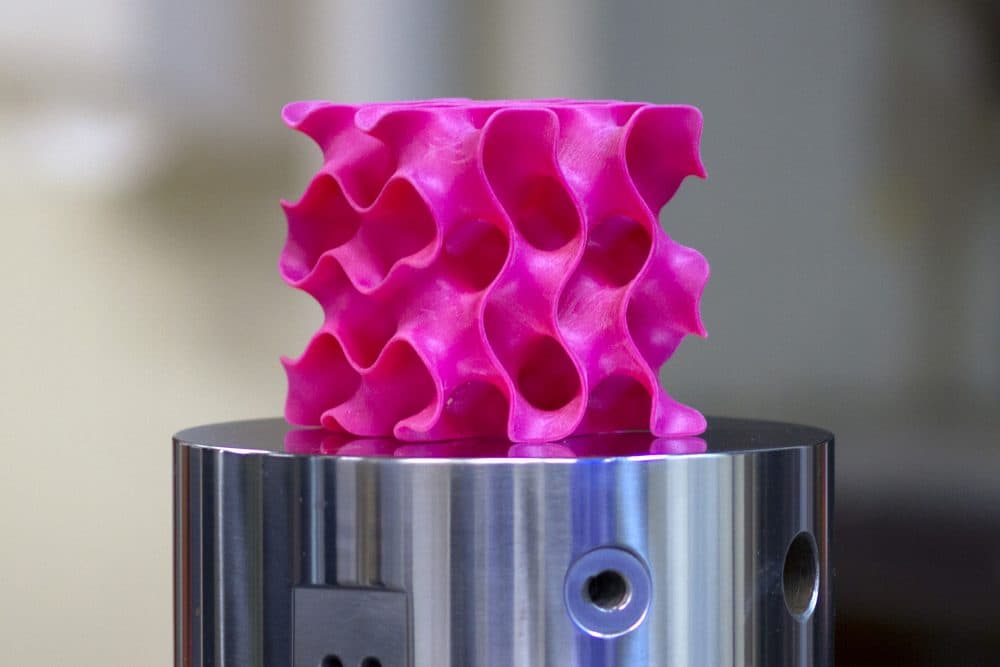Advertisement
'Using Weakness To Create Strength': MIT Engineers Discover Structure That Makes Materials More Resilient
Resume
Making big things out of the world's strongest material has been the goal of materials engineers for the past few years.
A team at MIT has figured out a way to do it, but along the way they made another discovery.
Starting With Graphene
You may never have heard of graphene, but you've used it before.
It's what makes a pencil work. Professor Markus Buehler, who runs MIT's Laboratory for Atomistic and Molecular Mechanics, explains that a pencil point is made of graphite, which is stacked layers of graphene. As you rub the surface of the pencil against paper, the sheets of graphene flake off.
"That's why we can write with a pencil, so we scrape off little layers of graphene, basically," Buehler says.
Graphene has a very strong bond along one plane, but weak bonds between the planes. That's why in a pencil, the sheets of graphene peel off when rubbed against the paper.
Graphene is the strongest known material, but it's also very, very thin -- so thin that it's essentially two-dimensional.
"It's one atom thick," Buehler says. "It's really hard to build anything useful out of it, other than maybe nano-scale devices."
Buehler says because graphene is two-dimensional, so far engineers have only been able to build very small things with it. But engineers would like to build bigger things. And it was in that pursuit that the MIT engineers discovered something else.
An Aha Moment
Buehler's team, which includes research scientist Zhao Qin, has figured out a potential way to fold graphene into a three-dimensional model out of which you could build bigger structures.
"So graphene conventionally was thought to be a two-dimensional, thin-field structure, but here we created a three-dimensional structure," Qin explains.
Graduate student Gang Seob Jung discovered a formula to describe the structure in its most perfect form.
"This geometry is already known, called gyroid," Jung says. "Based on Zhao's work, I applied some mathematical form to the modeling too, to build a different size of the gyroid structure of graphene."
Imagine a twisted honeycomb. But instead of a bunch of different sides all stuck together, Buehler explains that it only has two sides that fold over one another repeatedly.
"The surface in this gyroid is continuous," Buehler says. "So if you look at a small piece, it's always two-dimensional. It's always perfectly connected. But if you zoom out, it forms a three-dimensional structure, so you can build things with them."
So far, Buehler says, they've only been able to do this with computational models when it comes to graphene.
But they have been able to build this gyroid structure with plastic. Buehler says you could also use metals, concrete or glass with the help of 3-D printing.

"Geometry is really important for the property," Buehler says. "It's not so much the material itself."
And this is where the aha moment came for the engineers. They realized that with this new structure they discovered, they don't necessarily need to use a strong material like graphene. It was the shape that was the key. They could use other materials.
They also discovered that if they make the structure with thin walls, it's actually stronger than if they make it with thick walls.
When a plastic gyroid with thick walls is placed under pressure, it bursts. But when a plastic gyroid with thin walls is placed under pressure, it cracks but does not shatter.
'Using Weakness To Create Strength'
Buehler explains that's because with thin walls, the structure buckles instead of breaking.
"Using weakness to create strength is something that we see a lot in many biological organisms and living systems, in many proteins, actually in spider webs," Buehler says. "We see that the individual elements are very weak, and it's actually not a weakness for the whole system but it's a strength at the end of the day, because it allows for local failures to occur."
Break one strand of the web, and the web still holds together. Buehler says this concept goes against engineers' instincts, which is to build things out of the strongest possible materials.
"Because engineers typically like to over-design and make things very strong --stronger than necessary," Buehler says.
Their discovery was so important that they published it in the journal Science Advances.
The plastic gyroids Buehler and his research associates have made are cubical and spherical, but he says they could take any shape -- like an airplane wing.
"In the case of an airplane, or in the case of a car, or maybe in a building, I think the biggest advantage actually is that you don't need any welding or connecting points," Buehler says. "The reason why things break, usually, is because you have either welded them, you have screwed them, glued them, and these create stress concentrations that lead quickly to corrosion or lead to some kind of imperfections."
The engineer's dream is a light, super-strong structure without any weak points. These researchers are not there yet, but they are one step closer.
This segment aired on February 17, 2017.

